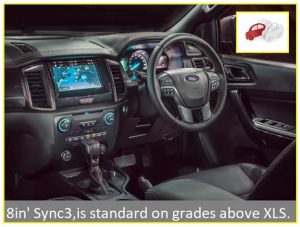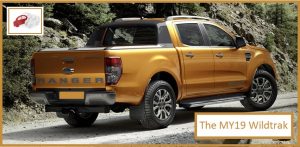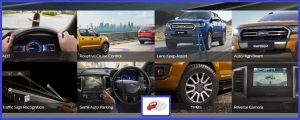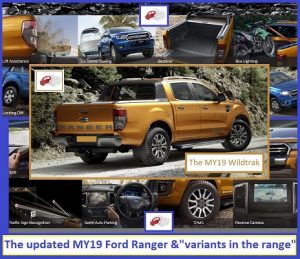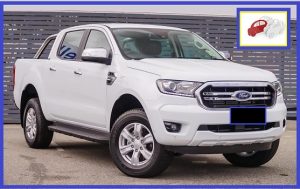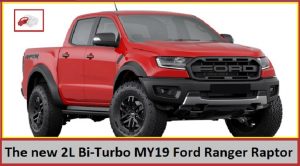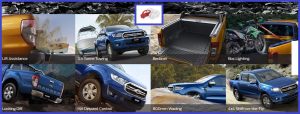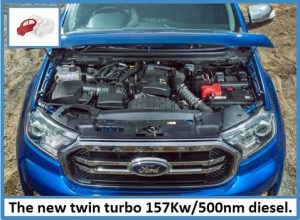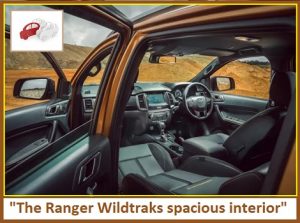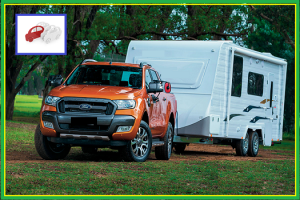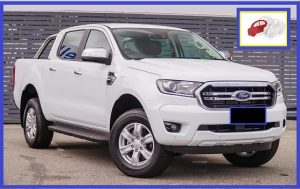DABAS blog post: late May 2019, the updated MY19 Ford Ranger range.
Hello readers, hoping all is going well, as the “official first-day of winter” and the 2019 snow season quickly approaches, in Victoria, Australia. Earlier this month DABAS’s blog post briefly looked at the 10 best-selling MY19 vehicles – so far – in 2019; the Ford Ranger variants took the silver medal, in second place behind the Toyota Hi-lux range. As it is now one of Australia’s best-selling vehicles month to month in 2019, the updated MY19 Ford Ranger is proving very popular amongst Australian families and tradespeople alike. There are more than 29 variants in the range: both single cab and dual cab, 4×2 and 4×4 options, and 3 different motors and transmissions available – pending your chosen variant.
The MY19 Ford Ranger’s entry-level pricing starts from $27,990 with the other variants heading upwards in price, adding in various bells and buttons, bling, safety acronyms and driveline options. The popular 28th choice for growing families is the Wildtrak double-cab pick-up 2.0L Bi-Turbo automatic variant at MRP $63,990, whilst your 29th choice, the range-topping Raptor double-cab pick-up 2.0L Bi-Turbo, automatic variant is at MRP $74,990. Psst – With end-of-financial-year sales around the corner, and Ford dealers keen to take the Toyota Hi-lux’s number-one podium position, DABAS is aware of many drive-away deals well under the above $MRPs. With that in mind – in this DABAS blog post – let’s have a generalised look at the recent updates of the MY19 Ford Ranger variants – with some brief comparisons to a MY18 Ranger – which may help in your search for a brand-new MY19 vehicle: more detailed research information, reviews and brochures – plus any special EOFY pricing offers that DABAS is currently aware of on a brand-new MY19 vehicle – will be provided upon your transition to becoming a DABAS client.
As with any big decision, it’s best to do research before stepping a toe into a LMCT dealership; DABAS can assist by doing this for you, looking at factors such as fuel economy, safety, technology, servicing schedules and costs, plus added extras that may all help in your final purchase decision, as each vehicle’s variant in the model range is usually available with progressing arrays of added inclusions that may suit your personal needs to a tee. Comparing new cars solo by yourself can be very time-consuming, and at times confusing, but with DABAS’s assistance the modest service fee charged for our services will have been well worth it when you get behind the wheel of your ideal dream car, knowing the vehicle suits your lifestyle and hip pocket, both now and in the long run!
We hope you find this blog post on the updated MY19 Ford Ranger range an interesting read, whilst shining some light on information that may assist you selecting a suitable vehicle for your personal car-buying needs, providing some useful “very general-in-nature” information to help you on your MY19 vehicle selection; If you would like DABAS’s assistance buying a vehicle, please click here.
Here we go, The MY19 Ford Ranger range of updates seem to have stuck with Ford’s winning formula, which made the Ford Ranger one of the best-selling vehicles in Australia recently (the number-two bestseller nationwide in March of 2019). The MY19 Ford Ranger is now nipping at the heels of the nation’s number-one-selling vehicle, the Toyota Hi-lux range. The MY19 update offers key mechanical and safety updates with only the bare minimum physical changes to the body and panel-work. The MY19 Ranger is available in dual-cab, cab-chassis, single-cab and super-cab variants. As mentioned in the opening paragraph, there is a vast array of models in the MY19 Ford Ranger range across four grades. Six have been dumped from 2018’s line-up, including the 2.2-litre, four-cylinder-powered 4×2 XL Hi-Rider and the 2.2-litre, four-cylinder 4×4 double-cab manuals, while four have been added in 2019. The price list remains surprisingly similar to the MY2018 across all trim levels; of course, how much you spend is up to you, as the MY19 RRP starts at $27,990 in 2wd single-cab chassis layout through to the first 4X4 variant starting at $41,890 for the 4×4 XL single-cab chassis manual, while as a guide the double-cab Wildtrak pick-up with the 3.2-litre five-cylinder turbo-diesel costs from $60,590 (manual) and $62,990 (auto) plus ORCs; and the range-topping Ford Raptor auto with its Bi-Turbo 2.0L motor is at $74,990 plus ORCs.
All MY19 Rangers benefit from a reworked front suspension set-up that sees the front anti-roll bar moved from in front of the axle line to behind it, which has allowed the Ford engineers to reduce its diameter and increase its strength. This in turn has allowed for softer front springs and shocks to be fitted. The Ranger variants have power windows, power mirrors, central locking, cruise control, climate-control air conditioning and a multimedia touch screen with Bluetooth. 4×4 Ford Rangers are fitted with an electronic differential lock, while the base model XL 4×2 Lo-Rider is the only RWD version to miss out on a limited slip differential. All MY19 Ford Ranger models do get hill descent control, hill start assist, ESP and power steering.
Compared to a MY18 Ranger, the entry-level MY19 Ranger XL features a darker interior treatment and very minor exterior updates that include chrome door handles and grille surround, along with a lift-assisted tailgate that reduces your lift effort by nearly 50%, The 118kW/385Nm 2.2L four-cylinder diesel and 147kW/470Nm 3.2L engines are carried over unchanged. It also gets xenon, rather than projector, headlights. The XLS gets the same set of updates, along with a tech pack that includes front sensors, an optional $1950 Sync 3 pack with eight-inch multimedia screen with sat nav, dual-zone climate control, digital radio and a smart key. This dual cab-only variant also gets different seat fabric, 16-inch alloy rims and foglights.
The XLT is the first of the MY19 Rangers to “optionally” feature the model’s biggest update: the 2.0-litre engine.
The XLT is the first of the 2019 Rangers to feature the model’s biggest update for the new MY19 year: the option to fit Ford’s latest 2.0-litre twin-turbocharged four-cylinder diesel engine that’s been copy/pasted from the Ranger Raptor (Pssst – and its stablemates, the 7-seater Ford Everest, Mustang and Transit), alongside the tried-and-true 3.2-litre five-cylinder diesel as a choice in the XLT. The top-specced Wildtrak is offered optionally with either the 3.2-litre five-cylinder diesel or the Raptors 2.0-litre Bi-Turbo diesel, this Bi-Turbo 2-litre engine has 157kW/500Nm of grunt and uses Ford’s 10-speed automatic transmission – as seen in both the Raptor and the Mustang GT – while the3.2-litre five-cylinder diesel has the six-speed transmission. It is an additional $1200 cost for the 2.0-litre Bi-Turbo, which gets you four more gears in the transmission, one less cylinder in the motor and 10kW/30Nm more power. It has keyless entry with push-button start, while, if optioned, the optional $1700 tech pack gives you AEB with pedestrian detection, traffic-sign recognition within the navigation system and automatic park assist – which by the way is a first for a dual-cab ute in Australia. There are also 18-inch alloys in black as an option, while LED daytime lamps, roof rails (no roof racks, though), a tailgate liner and HID headlights are included, along with LED driving lights in a new front bumper fascia. The easy-lift tailgate is also connected to the Wildtrak’s central locking system. Accessories like a bull bar, snorkel, nudge bar, ladder rack are an aftermarket affair, but a sports bar is offered on XLT grades and up.
If you just want an MRP price list (plus the ORCs), this should assist:
The Ford Ranger 4×2 variants: XL single cab-chassis 2.2L manual is $27,990; XL single cab-chassis 2.2L Hi-Rider auto is $33,690; XL super cab-chassis 2.2L Hi-Rider auto is $36,190; XL double cab-chassis 2.2L Hi-Rider auto is $38,190; XL double-cab pick-up 2.2L Hi-Rider auto is $39,690; XLT double-cab pick-up 3.2L Hi-Rider auto is $50,290; XLT double-cab pick-up 2.0L Bi-Turbo Hi-Rider auto is $51,490.
The Ford Ranger 4×4 variants: XL single cab-chassis 3.2L manual is $41,890; XL single cab-chassis 3.2L auto is $44,090; XL super cab-chassis 3.2L manual is $44,390; XL super cab-chassis 3.2L auto is $46,590; XL super-cab pick-up 3.2L auto is $48,090; XL double cab-chassis 2.2L auto is $46,090; XL double-cab pick-up 2.2L auto is $47,590; XL double cab-chassis 3.2L manual is $46,390; XL double cab-chassis 3.2L auto is $48,590; XL double-cab pick-up 3.2L manual is $47,890; XL double-cab pick-up 3.2L auto is $50,090; XLS double-cab pick-up 3.2L manual is $49,190; XLS double-cab pick-up 3.2L auto is $51,390; XLT super-cab pick-up 3.2L auto is $56,190; XLT super-cab pick-up 2.0L Bi-Turbo auto is $57,390; XLT double-cab pick-up 3.2L manual is $55,990; XLT double-cab pick-up 3.2L auto is $58,190; XLT double-cab pick-up 2.0L Bi-Turbo auto is $59,390; Wildtrak double-cab pick-up 3.2L manual is $60,590; Wildtrak double-cab pick-up 3.2L auto is $62,790; Wildtrak double-cab pick-up 2.0L Bi-Turbo auto is $63,990; Raptor double-cab pick-up 2.0L Bi-Turbo auto is $74,990.
Exterior design updates in the MY19 Ford Ranger: mmmn, not a lot to report here; chrome door handles and grille surrounds for XLT variants, along with a new front bumper skin on the Wildtrak, are about the extent of the exterior design changes, compared to the MY2018 Ranger. The MY19 Ranger’s interior reveals a similar story; compared to a MY18, there is more black headlining through the entire range, with interior finishes that are more subtle and not as reflective. The Wildtrak gets leather-accented seating bundled as standard, while in the XLT’s cabin it can be optioned if desired. Side steps feature on XLT and Wildtrak and a rolltop-type hardtop lid comes standard on the Wildtrak dual-cab tray utility body, with a rear-step bumper, (psst, no soft-top canopy though). The Wildtrak misses out on the awesome wheel arch extensions that feature on the Raptor, sadly. Ford Ranger dimensions remain the same for the MY19, including interior dimensions and dual-cab tub dimensions. Ford Ranger MY19 colours: there are white, red, blue, silver, grey and black, while the Wildtrak comes in Saber orange. No green or yellow and there are no options for two-tone paint. You can’t option for a sunroof, either, and the MY19 Ford Ranger isn’t offered with an off-road pack or dual-battery option as standard, in any of the variants.
Interior space: there’s no real change over the MY18 model. The MY19 model has a small, deep centre console bin and an oddments tray under the centre console, along with two line-astern cup holders up front and two in a pull-down centre armrest in the second row of the dual cab, and it can handle five passengers (in dual-cab variants). Rear legroom is satisfactory, and headroom is acceptable. The angle of the seat backs isn’t too vertical. The dual cab’s second row has ISOFIX mounts for two baby seats, as well. Bottle holders are present in the shallow door pockets, and there’s a tray on the top of the dash that sports a 12-volt socket. There are two USB ports and another 12V socket under the console, and a 230V universal plug and another USB port for the second row in dual-cab and super-cab Rangers. There’s also a 12V socket in the tray. The cab-chassis can accept a steel tray, an aluminium tray or flat tray.
Boot space: even for a ute, the cargo capacity of the Ranger’s styleside tray isn’t measured in litres, but in millimetres. At 1549mm long by 1560mm wide, the width drops to 1139mm between the wheel arches at the floor. A canopy is a common optional addition, too. The Sync 3 system is offered as an $1950 option in the XLS and standard in XLT and Wildtrak. It comes with Apple CarPlay/Android Auto compatibility. A spare tyre and full-size rim – along with a small tool kit – are placed underneath the rear of the Ranger, and underbody protection guards the sump and gearbox.
Towing: The Ford (*upper-level drivetrain variants) Ranger’s towing capacity is 3500kg of braked trailer (that’s the*3.2-litre and the Raptor *Bi-Turbo 2-litre; the entry-level XL’s motor is less at 2500kg) and a tow bar is standard on all models above the XLS 4×4.
The engines and transmissions on offer: The Ranger is the only ute range to offer three different diesel engine sizes and specs and all three will be offered in 2019. All three diesel engines use a diesel particulate filter system.
The 2.2-litre four-cylinder turbocharged diesel makes 118kW and 385Nm and is used mainly used in the entry-level 4×2 models. It can be had with either a six-speed manual or six-speed auto, with the latter doing the best job of distributing the Ranger’s horsepower.
The 3.2-litre five-cylinder turbo diesel, meanwhile, makes 147kW and 470Nm, and uses the same two six-speed gearbox options.
The 2.0-litre four-cylinder twin-turbo diesel is the newest engine in Ford’s Ranger range and debuted in the Transit last year. In the more highly tuned Ranger, it makes 157kW and 500Nm, and is backed by a 10-speed auto.
Note: some overseas markets offer a petrol motor version. It’s unlikely we’ll ever see it here; neither is EV nor LPG possible.
How much fuel does it consume? The 2.0-litre Wildtrak indicated fuel consumption figures of 7.4L/100km on the combined fuel economy cycle; the Wildtrak 3.2’s fuel economy is rated at 8.9L/100km, and the XL dual-cab 4×4 2.2’s mileage is 8.0L/100km. When it comes to manual vs automatic fuel consumption, the manual 3.2 reportedly returns 8.3L/100km. The Ranger has an 80-litre size fuel tank as standard, while a long-range fuel tank is an aftermarket proposition.
Weight-wise, the Wildtrak comes in at 2246kg at the kerb, and 3200kg gross vehicle weight (or GVW), meaning it’s able to deal with a payload/load capacity of 954kg. Its gross combined weight when hauling a trailer, therefore, is 6000kg.
Safety: the Ranger has a maximum five-star ANCAP safety rating across the board and offers full-length curtain airbags amongst its complement of six. Technical safety aids like auto emergency braking (AEB) with pedestrian detection (on Wildtrak and optional on XLT), reverse camera, rollover mitigation, hill control assist and trailer sway control are all standard safety features. There is a tyre pressure monitoring system included as standard across most of the line, while lane assist comes as part of the XLT Tech Pack.
Warranty: Ford now offers an extended warranty of five years as standard, with unlimited kilometre coverage.
Servicing: the service intervals are at every 15,000km or 12 months.
Trivia– If you’re wondering where the Ford Ranger is built, for the Australian market, it comes from Thailand, and if you’re wondering if the diesels use a timing belt or chain, we can tell you all three use the former. The 2.0-litre Bi-Turbo motor uses a belt-in-oil set-up.
Verdict/summary: Park the MY19 Ranger next to an MY18 version in your local Woolworths supermarket, and only the most hawk-eyed train spotters will tell the difference externally. The key engineering changes, though, have made a real difference in the way that the Ranger presents as a privately bought family rig. The suspension changes are most effective at lower speeds, and the new 2.0-litre twin-turbo engine is torquey, economical and quiet. Add to that driver aids like AEB on the higher grades, and the Ranger is set to grace the top end of the vehicle sales charts for some time to come. Even maybe taking the gold-medal sales spot from the Toyota Hi-lux.
Free DABAS tip: The budget-conscious buyer’s value choice is the 2.0-litre XLT with the optional tech pack and black 18-inch rims. The tech pack gives the XLT all the safety benefits at much less cost than the Wildtrak.
….. At DABAS we know that buying a car to suit your needs can be one of the biggest purchases in your life. We hope this intended to be “general-in-nature advice and information” blog page has provided some helpful assistance for you in deciding the path of your car-buying journey. Please note any examples, options, pricing and information mentioned in this blog post are to be considered as a very general-in-nature summary; all specifications, information and advice mentioned in this blog page may be outdated or superseded by the time of your reading of this blog page; information in all DABAS blog pages will be confirmed at the time of you updating into your next vehicle, along with your chosen vehicle’s sales representative in their LMCT showroom at the time you transition to becoming a client of DABAS. We look forward to having a chat when the need arises for you to update your car; to assess your personal car-safety requirements and buying needs to suit your lifestyle. And importantly your set specified budget!
Whatever roads your life journey takes you on, DABAS can help you find a car to travel those roads.
When it comes time to update your car DABAS is aware of some things to consider within the many featured model range variants inclusions, plus more of the opposition comparisons, and also things to keep in mind – including when you are trading in your old car at a LMCT used-car yard – and the special trade-in incentives offered on drive-away-no-more-to-pay deals obtainable – at times – within leading brands’ Melbourne LMCT new-car dealerships. These will be discussed upon your transition to becoming a client of DABAS.
To contact DABAS to discuss your car-buying needs; please click here
For information on seven-seater towing vehicles; please click here
For information on environmentally minded cars; please click here
To see a self-evaluating check list – is it time to update your car; please click here
To see some interesting things to consider when buying a car; please click here
To see 3 things to consider when moving on from your old car; please click here
For a DABAS blog on comparing vehicle manufacturers’ warranty periods; please click here
If you would like to go to the car auctions as an alternative car-buying option; please click here
For “more” DABAS past blog topics (including towing and tyre safety tips); see our archived index here
For a step-by-step example of a DABAS car-buying journey; please click here
PSst; Keep in mind that DABAS is aware of some Ford dealers that often have Rangers in the yard for a keen drive-away price well below the RRPs; these prices will be discussed upon your transition to becoming a DABAS client.
Thanks for visiting DABAS’s website and blog
Have a great day, Cheers, Tim.
–Please note; information mentioned on this page is to be considered as a general-in-nature summary; all information and advice mentioned may be outdated or superseded by the time of your reading of this page; all information will be confirmed at the time of your transition to becoming a client of DABAS.